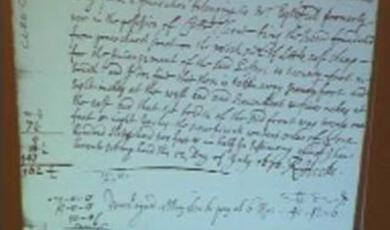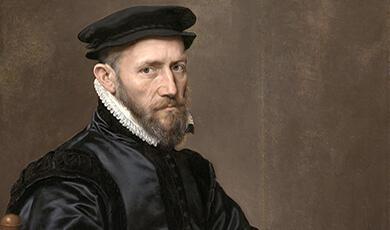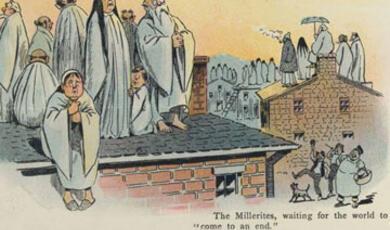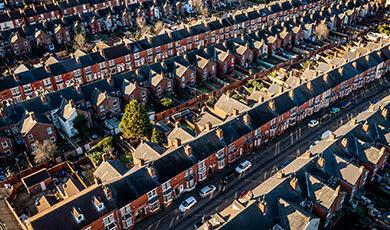The Long Shadow: The Great War and International Memory, 1914-2014
Share
- Details
- Text
- Audio
- Downloads
- Extra Reading
1914-18 casts a long shadow across the 20th century. This lecture explores some of the ways it has been remembered and memorialised, arguing that each country has its own Great War and that British memory is especially distinctive - still shaping attitudes to continental Europe in our day.
Download Text
8 December 2014
The Long Shadow:
The Great War and International Memory, 1914-2014
Professor David Reynolds
In my book The Long Shadow: The Great War and the Twentieth Century I offered three fundamental arguments. First, that British attitudes to the Great War have changed significantly over time. In other words, there isn’t a set, received view of 1914-18 that has endured over the last century: attitudes to the conflict have shifted in the light of current beliefs and priorities. Secondly, I think we can see this best by comparing British conceptions of the war with those of other countries, so my book is deliberately a piece of comparative history. I had in mind Kipling’s question: ‘what should they know of England who only England know?’ And thirdly, I argued that in this country and elsewhere 1914-18 is generally seen through the prism of 1939-45. Although chronologically the First World War occurred before the Second World War, conceptually the Second World War came before the First. In Britain in 1914-18 and during the 1920s and 1930s the conflict was known as the ‘Great War’, whereas in Germany and America it was always called the World War. Britain only adopted that terminology after 1945, when 1914-18 was seen as part of a sequence: First World War and Second World War.
This evening I want to develop these propositions, especially the argument that 1914-18 is usually seen in all our countries through the prism of 1939-45. Let me offer four brief examples from four foreign countries – Russia, America, France and Germany, before turning in more detail to the case of Britain.
For the whole of the Soviet era until 1991, the war of 1914-17 was seen essentially as an imperialist war that triggered the Bolshevik Revolution and was then eclipsed by the Revolution and by the ensuing civil war. Maybe two million Russians died in 1914-17, and then at least five million in the civil war that followed. So, in terms of casualties, Russia’s world war was less significant than its civil war. The war that was and still is memorialized on a heroic scale in Russia is the great Patriotic War of 1941-45, which became, after Khrushchev’s Secret Speech of 1956 denouncing Stalinism, the prime legitimation of the Soviet regime. The national sacrifice to vanquish Nazism was the party’s justification, a way of demonstrating its validity, effectiveness and heroic status. It is striking, as historian Catherine Merridale has noted, that, during the whole Soviet period, there were no official war memorials to the conflict of 1914-1917. This shows how far the whole episode was airbrushed out of history. The situation has changed a bit since 1991, with more memorialization of 1914-17, but this hasn’t changed the basic contrast. So if we compare Russia’s public memory of the two wars, what we have is a negative First World War and an extremely positive Second World War.
Consider, secondly, the United States, which did not enter the conflict till April 1917. The Wilsonian crusade to ‘make the world safe for democracy’ collapsed when the President failed to get the League of Nations through the US Senate. By the 1930s a powerful backlash had set in, with deep disillusionment about American involvement in the war and what it had achieved, together with a strong conviction that the country must not get into such a situation again. However, after Pearl Harbor in 1941, the mood changed again. Wilson was viewed positively rather than negatively, becoming in 1944 the centrepiece of the State Department’s campaign for the United Nations which was portrayed as America’s ‘second chance’ to do what Wilson tried and failed to achieve. These attitudes have endured. The war of 1941-45 is for Americans still a ‘good war’, with a clear moral cause, which made the United States into a superpower and was won by what is widely known as the ‘greatest generation’. The First World War is not well known but today the American view of it is essentially positive, while the Second World War is viewed as overwhelmingly positive. So here we have a very different pattern from the Soviet Union.
For France the story is different again. 1914-18 was and still is regarded as a noble sacrifice: to cleanse the homeland, which had been occupied by the Germans in the north-east, and to recover Alsace and Lorraine, lost in 1870. That view is set against the deep and abiding problems the French have with the Second World War. Whereas in 1914-18 there was always a Western Front, in 1940 the Western Front collapsed in four weeks. In 1914-18 something like 1.3 million Frenchmen died; in June 1940 roughly 1.8 million Frenchmen marched off to German prisoner-of-war camps. So here is a vast contrast: 1940 was a huge humiliation for France and, as the Vichy regime’s complicity in Nazi genocidal programmes became apparent from the 1970s, the French have been forced to wrestle with huge moral issues. French politics were wracked for years by divisions between those who collaborated and those who resisted. So what you have in the case of French public memory is a positive Grande Guerre but a Seconde Guerre that is very problematic, very negative.
The German story is different again and equally interesting. 1914 was presented in Germany as a defensive war against aggression from the east – the Russians, after all, had invaded East Prussia – and this perception was accentuated in the 1920s with celebrations of Hindenburg, in particular his smashing 1914 victory over the Russians at Tannenberg. That image of 1914-18 as a defensive war lingered even after the Second World War, which was unequivocally accepted as an evil war. West Germans acknowledged the crimes perpetrated in their name by the Nazi regime – in a way that has not been the case, for example, in Japan where open public debate about the Second World War has been minimal – but, even in the 1950s, the German view of World War One remained essentially positive, or at least that the war had justification. That is until Fritz Fischer, an influential leftist historian who insisted that there was a continuity of German history – a tradition of imperialism and militarism that dated back at least to Bismarck – and who depicted both world wars as a story of aggression and expansion. This Fischerite paradigm has now begun to shift in Germany as a result of the new centenary-driven interest in 1914-18, with historians such as Christopher Clark and Sean McMeekin shifting the blame game towards the Balkans and Russia, but there is still in Germany a widespread acceptance of substantial national responsibility for 1914, especially in the west with regard to the invasions of France and neutral Belgium. So for modern Germans, one can say, the First World War has been seen as negative and the Second World War as super negative.
So what I am suggesting is that we have four different countries with four different takes on the same story. For the Russians there was a negative First World War and a positive Second World War; in the USA a positive World War I and a super-positive World War II; for the French the First World War was positive and World War II deeply negative; and for Germany, there was a negative perception of the First World War and a super negative perception of the Second World War.
It is important to emphasize that the process of coming to terms with the past for many continental European countries has meant not only discussing historic events but also moving on from them. This is what the Germans signify by their concept of Vergangenheitsbewältigung– the struggle to master the past. With that in mind, I suggest that the Treaty of Rome in 1957, which formed the European Community, was essentially the peace treaty in the west for the Second World War. There wasn’t a formal peace treaty because the wartime allies could not agree on basic issues, especially the German question, but effectively the Treaty of Rome represented the moment when, just twelve years after the demise of Nazism, France and Germany came together in a completely different international organisation. The European Community helped to move those two countries on, not just from 1939 but also from 1914, 1870 and 1806 – in fact the whole tit-for-tat cycle of conflicts between France and Germany that had shaped and scarred Europe over the previous centuries. It is still amazing, I think, that such a revolution in European history happened so quickly. It was assisted by other states, with the Benelux countries acting as midwives to the birth of a new Western Europe, but it still required an immense change of attitude on the part of French and German leaders.
Let me develop this point by reference to Konrad Adenauer and Charles de Gaulle. De Gaulle had spent half of World War I in a German prisoner-of-war camp. Adenauer’s first visit to Paris was to see the German delegation at the Paris peace conference in 1919, just a few days before it was forced to sign the Treaty of Versailles. So, neither of these two men might have been expected to get on very well. What’s more, de Gaulle had not been in favour of the European Community although, by the time he became French President in 1958, the EEC was up and running, so he had to accept this as a fait accompli.
Obliged to arrange a meeting with the German Chancellor, de Gaulle did something quite remarkable. He invited Adenauer to his country house at Colombey-les-Deux-Eglises. I think this was the only time that de Gaulle, a deeply private man, welcomed a foreign statesman into his home. Adenauer did not appreciate the full significance of the invitation in advance and, as his car was driven across the old battlefields of the Franco-German past, he reflected gloomily on the forthcoming encounter. But this turned out to be a quite transformative experience for both men. De Gaulle still spoke reasonable German, so they dispensed with interpreters quickly and had a very familial meeting, getting on extremely well. Adenauer became convinced that de Gaulle was serious about a new relationship with Germany and de Gaulle recognised in Adenauer a German who had stood out against the Nazi regime as mayor of Cologne and had drawn his own country into a new era after 1949. A few years later, in 1962, in Reims Cathedral, the two men took Mass together at the High Altar. Reims was the coronation place of French kings, going back many centuries, and the site of one of the most notorious ‘atrocities’ of 1914 – the shelling of the cathedral by German artillery. So the meeting of Adenauer and de Gaulle in Reims in 1962 was hugely symbolic and a very moving sign of this sudden Franco- German reconciliation.
So far, I have suggested that, first, different countries have different perceptions of these two world wars and, second, that some of our continental partners have moved on from being hung up about those wars. Now, I want to develop the British story – arguing that we, too, have a distinctive take on the two wars seen in tandem, but also that we have not been able to move on in the same way from 1914-18 and 1939-45.
The Great War was the deadliest conflict in British history, with nearly three-quarter of a million dead. It was impossible to bring such a large number of bodies home. Indeed many soldiers had been literally blown to bits by shellfire and their remains were never located. So the dead were buried with reverence along the battlefronts in nearly a thousand cemeteries and monuments constructed by the Imperial War Graves Commission in one of the biggest British public works projects of the 1920s.
Among the missing was Jack Kipling, only son of the celebrated author Rudyard Kipling, who was last seen stumbling in agony across the battlefield of Loos in September 1915 with half his face blown off. Jack could have secured a medical exemption on grounds of short-sightedness but he and his father were passionate patriots. After 1918 the anguished Kipling devoted his energies to the war graves project, as did the architect Edwin Lutyens and the administrator Fabian Ware. Too old to fight, they were all consumed by grief and probably guilt about the young men who had been sent to their premature deaths.
During the war itself the public knew little of the gruesome reality of modern industrialized killing. Press reporters were strictly regulated and there was virtually no film footage of combat or corpses. But during the Twenties, the veil was partially lifted by veterans through literature, such as the stylised memoirs of Siegfried Sassoon and Robert Graves or the play Journey’s End by R.C Sherriff, praised for its ‘realism’ in bringing alive the psychological horror of the trenches. The author J.B. Priestley called it ‘the strongest plea for peace I know’.
As the Thirties progressed, this link between peace and remembrance grew stronger. Many people felt that the dead would not have died in vain if 1914-18 proved to be, in the cliché of the time, ‘the war to end war’. In a sense, peace would be the most sincere form of remembrance. By the mid-1930s Britain had the largest peace movement in the world. Over a third of the population – 11.5 million people – signed the so-called ‘Peace Ballot’ of 1935, with an overwhelming majority endorsing the League of Nations and advocating an end to the arms trade. And, as war clouds gathered in 1938, Prime Minister Neville Chamberlain made his own bid for peace in a desperate deal with Hitler at Munich. Chamberlain was another of the generation that was too old to fight. He had never recovered from the loss of his younger cousin and closest friend, Norman, on the Somme.
But on 3 September 1939 Britain was at war once again with Germany: all the peace-talk and peace-making had come to nothing. This new conflict turned out profoundly differently from the last. All through the Great War there had been a Western Front but in 1940 the fall of France in four weeks left Britain fighting on alone. Unlike 1914-18, the country was heavily bombed and menaced by imminent invasion: 1940 became immortalized in Churchill’s phrase as Britain’s ‘finest hour’. And this war, unlike the last, ended with Germany’s unconditional surrender and occupation by the Allies, by which time the inhuman criminality of Nazism had been exposed with the opening of camps such as Belsen and Buchenwald. So 1939-45 seemed unquestionably a ‘good war’. Moreover, it had been won, as far as Britain was concerned, at half the human cost of the last. The shift of terminology, which I mentioned earlier, from ‘Great War’ to ‘First World War’ accentuated the sense that 1914-18 had been an inconclusive opening round, which needed another round in 1939-45 to finish the job.
After 1945 the rituals of Armistice Day, the Eleventh of November, and the Two-Minute Silence slipped out of fashion. Instead the dead of both world wars were honoured on the nearest weekend, dubbed Remembrance Sunday. During the 1950s and 1960s the British seemed obsessed with Hitler’s war. It was commemorated, even celebrated, in more than a hundred colour movies showing squared-jawed, stiff-upper-lipped British heroes such as Jack Hawkins and Richard Todd doing battle with wicked Nazis in classics such as The Cruel Sea and The Dambusters – a genre transmuted from high drama to picaresque farce by Dad’s Army in the mid-1960s. Recycled on television right up to the present day, these media depictions still inform British images of ‘our finest hour’.
Preoccupied with the era of Churchill and Hitler, postwar Britons paid little attention to 1914-18, until the fiftieth anniversary in the 1960s served to revivify the conflict for a new generation. The epic BBC TV series The Great War screened previously unseen footage of the trenches. And the value and validity of the war was questioned in books such as The Donkeys by Alan Clark, who popularized the phrase that British Tommies had been ‘lions led by donkeys’. This theme of innocent soldiers sent to their deaths by stupid aristocratic generals was dramatized in Oh! What a Lovely War – an experimental play that mushroomed into a West End hit and then Richard Attenborough’s movie. And the new vogue for ‘history from the bottom up’ spawned a series of studies of Pals Battalions, pioneered by Martin Middlebrook’s First Day on the Somme, which heightened the sense of ordinary soldiers as sacrificial victims.
The Sixties were also the decade when the British discovered the ‘War Poets’ or at least a few of them. It is worth noting that some 2,200 writers published poetry about the Great War between 1914 and 1918, twenty-five percent of them women and fewer than twenty percent men in uniform. Yet since the 1960s, thanks largely to fiftieth-anniversary anthologies, a few ‘soldier poets’ have become the true interpreters of the ‘pity of war’ for generations of schoolchildren through the English literature curriculum. Supreme among them was Wilfred Owen, whose poems evoked the ‘pity of war’ and whose death in action a week before the Armistice seemed to sum up the conflict’s futility.
Recently Gary Sheffield and other revisionist military historians have attacked these Sixties stereotypes of lions led by donkeys, insisting that the British army learned from the disastrous first day of the Somme and developed into an efficient war machine that combined infantry, tanks, artillery and aircraft to deadly effect in its victorious last ‘Hundred Days’ in 1918. But this so-called ‘learning curve’ was greased with a terrible amount of blood: whether such a costly education can be justified remains a matter of debate.
The Sixties were, in fact, when British remembrance of the Great War set firm, heightening the contrast with the country’s positive remembrance of 1939-45. All the belligerent countries, I have suggested, see 1914-18 through the lens of 1939-45, and some of them cling equally devotedly to the war against Hitler as a defining moment in national history – the Russians being a notable example. But others have found a way to escape from the prison of memory. For France, Germany and their Benelux neighbours, European integration has offered a way out of their darkly entangled history, transmuting pained remembrance of the past into hope for a brighter future. In Britain, however, this exit strategy has never had much appeal. Not until the British Empire had been virtually liquidated did the United Kingdom, in 1973, join the European Community. But by then the bargains among the original Six had set firm, which meant that the UK joined on terms that did not suit key national interests, especially on agriculture and the budget. In the twenty-first century this country still remains an ‘awkward partner’, frequently at odds with majority policy, and now there is mounting political debate about whether we should remain members of the European Union.
Our distinctive patterns of war remembrance are, I think, an important part of the explanation for this sense of alienation. The First World War, costly yet inconclusive, left troubling questions about whether Britain should have intervened on the Continent. The Second World War – in which Britain triumphed with the help of the ‘English-speaking peoples’ of the Commonwealth and the United States – accentuated that sense of distance, so that the Atlantic often seems narrower than the Channel. A country that still celebrates 1940 as its ‘finest hour’ will, by definition, find it hard to look forward into a better future. But I think that exit from the European Union, despite the EU’s manifold problems and inefficiency, would be a step backwards – the politics of nostalgia. In the twenty-first century, it seems to me, the British, even more than the Germans, are engaged in a struggle to master their past.
© Professor David Reynolds, 2014
This event was on Mon, 08 Dec 2014
Support Gresham
Gresham College has offered an outstanding education to the public free of charge for over 400 years. Today, Gresham College plays an important role in fostering a love of learning and a greater understanding of ourselves and the world around us. Your donation will help to widen our reach and to broaden our audience, allowing more people to benefit from a high-quality education from some of the brightest minds.


 Login
Login







